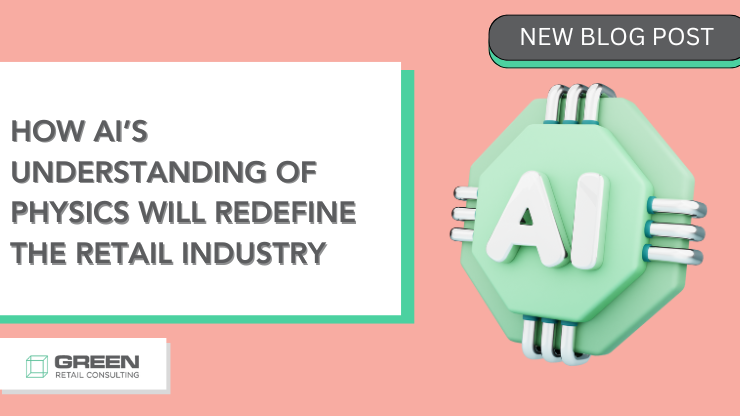Artificial intelligence (AI) has reached a groundbreaking milestone: the ability to understand and simulate the physical world. This achievement goes beyond theoretical interest, offering transformative potential across industries. In retail, where customer experience, inventory management, and operational efficiency are paramount, leveraging AI’s newfound ability to model physical environments could unlock unprecedented opportunities.
Historically, AI’s strength has been in data-driven insights and pattern recognition. However, with advancements in AI’s understanding of physics, we now have systems capable of simulating and predicting physical interactions with remarkable accuracy. This capability enables AI to model how objects behave under various conditions, offering valuable insights for industries that rely on physical products, spaces, and logistics.
Applications in Retail

1. Optimizing Store Layouts AI can simulate customer movement within a store, predicting how they interact with shelving, displays, and products. By analyzing these simulations, retailers can design layouts that enhance traffic flow, maximize exposure to high-margin items, and create an intuitive shopping experience.

“As a warehouse manager for a supplement company with over 5,000 SKUs, one of our biggest challenges is efficiently locating products to fulfill orders quickly. Piloting AI technology to simulate and optimize our warehouse layout could be a game-changer for our operations. By using AI-driven digital twin technology, we could create a virtual replica of our warehouse to model and test various storage configurations. For example, AI could analyze picking patterns and product demand to determine the best placement for high-turnover items near packing stations, while slower-moving items could be stored farther away. This optimization would reduce travel time for our staff and improve order processing speed. Leveraging this technology would streamline operations, reduce errors, and improve productivity.”
Ecommerce Business Owner, Supplement Warehouse
2. Advanced Supply Chain Modeling
Understanding the physics of transportation and storage allows AI to optimize packaging, stacking, and shipping methods. For instance, AI can imitate how different materials and configurations affect product safety during transit, reducing damage rates and costs.
3. Virtual Try-Ons with Enhanced Accuracy
The integration of physics in AI can take virtual try-ons to the next level. From fashion to furniture, AI can now mimic how clothing drapes on a body or how a couch fits into a specific room, offering a more realistic and satisfying digital shopping experience.
4. Inventory Forecasting and Space Optimization

By modeling the physical dimensions and storage requirements of products, AI can better predict how to optimize warehouse and store space. This ensures efficient inventory turnover and reduces wastage or overstocking.
5. Sustainability in Packaging and Logistics
AI-driven simulations can identify eco-friendly alternatives for packaging and shipping by analyzing material strength, weight, and recyclability. This supports retailers’ sustainability goals while maintaining operational efficiency.
Real-World Example: Simulating Customer Interaction
Imagine a clothing retailer using AI to mimic how customers interact with different rack heights, aisle widths, and lighting conditions. The AI might reveal that placing high-demand items at a specific height boosts sales by 15%, or that certain lighting enhances the perceived quality of products. These insights can guide data-driven design changes that improve both customer satisfaction and revenue.
Challenges and Considerations
While the potential is immense, integrating physics-enabled AI into retail operations requires careful planning. Retailers must ensure they have the infrastructure to handle complex imitations and the talent to interpret and act on AI-driven insights. Ethical considerations, such as ensuring that AI tools are used responsibly and transparently, must also be addressed.
The Future of Retail with AI
As AI’s capabilities expand, so too will its applications in retail. From creating hyper-personalized customer experiences to achieving operational excellence, the ability to model and predict the physical world positions AI as a cornerstone of retail innovation. Retailers that embrace this technology early will be better positioned to lead in an increasingly competitive market.

“Using AI to simulate warehouse layouts is a game-changer for streamlining logistics. Imagine running virtual tests to find the best way to organize inventory for faster pick-and-pack times or to optimize paths for forklifts and workers. AI can predict bottlenecks, suggest ideal storage zones for high-demand items, and even simulate how new equipment or workflows would impact efficiency. It's like having a crystal ball for your logistics—saving time, cutting costs, and boosting productivity before you move a single pallet.”
Founder & CEO, Prose
The intersection of AI and physics represents a new frontier for the retail industry. By leveraging this breakthrough, retailers can reimagine everything from store layouts and supply chains to virtual experiences and sustainability initiatives. At Green Retail Consulting, we’re excited to help businesses harness the power of this cutting-edge technology to drive growth, innovation, and customer satisfaction.
Take a look at what other industry experts had to say about the revolution of AI in the retail sector:
Transform Warehouse Operations with AI Modeling
At Tech Advisors, we have seen firsthand how AI's ability to simulate and model physical environments can transform warehouse operations. For instance, one of our clients in the retail sector piloted AI technology to redesign their warehouse layout. The AI analyzed inventory patterns and order frequencies to create a more efficient design. This adjustment reduced the distance workers traveled between high-demand items, speeding up order fulfillment and cutting labor costs.
We are also exploring the integration of AI-powered simulations for inventory management. Simulating demand surges, like during holidays or sales, allows warehouses to prepare in advance. AI-driven models can identify the best placement for seasonal items, ensuring faster access and minimizing disruptions. These insights save time and help employees focus on delivering quality service to customers.
For stores, AI simulations can test layouts before physical changes are made. We've worked with businesses to model shelf arrangements, improving customer flow and product visibility. Small changes, like adjusting high-traffic areas, have significantly boosted sales for our clients. These examples highlight how embracing AI modeling can bring tangible benefits to both efficiency and customer experience.
- Konrad Martin, CEO, Tech Advisors
Simulate Store Layouts to Boost Sales
I'm currently piloting AI to optimize warehouse layouts for faster order fulfillment. Using a simulation model, I analyze item picking patterns and adjust shelving layouts to minimize travel time. For example, AI showed that clustering high-demand items closer to packing stations cut our fulfillment time by 30%. I'd also love to use this for retail stores-simulating foot traffic to design layouts that drive more sales. By modeling shopper behavior, I could identify dead zones and reposition displays to maximize engagement. The beauty of AI simulations is the ability to test multiple scenarios without disrupting operations. It's like having a blueprint for efficiency before making costly physical changes.
- Nikita Sherbina, Co-Founder & CEO, AIScreen
Enhance Storage Efficiency with AI Simulations
At Optima Self Store, we see significant potential in using AI to simulate and optimize our storage unit layouts. By modeling customer behavior and usage patterns, AI could help us design layouts that maximize space efficiency while improving accessibility for clients. For example, we could pilot the technology to determine the ideal placement of larger units versus smaller ones, based on demand trends and traffic flow within the facility. Additionally, AI simulations could be used to predict seasonal storage needs, allowing us to preemptively allocate space and resources for peak periods, such as during moves or holiday storage surges. This technology would not only enhance operational efficiency but also ensure a smoother, more convenient experience for our customers.
- Alex Morgan-Jones, Operations Manager, Optima Self Store
Recreate Immersive Online Fragrance Shopping
AI's ability to simulate physical environments offers exciting opportunities for perfume houses because buying a new perfume online is notoriously difficult since you can't smell it.
At Pairfum London, we are keen to pilot this technology to recreate an immersive in-store shopping experience but online. Imagine a virtual consultation where customers can explore fragrances and learn about notes and compositions as if guided by a personal expert.
We plan to use AI to simulate the experience of speaking with our in-house perfumer, Huib Maat. This would allow customers to discover the perfect fragrance while gaining a deeper understanding of perfume artistry. By recreating the store layout virtually, we could test how customers move through the space, ensuring product placement enhances exploration and delight. Such simulations would allow us to refine the customer journey and create an atmosphere that mirrors the elegance of a physical boutique.
We hope this approach can bridge the gap between digital and physical retail by offering a personalized and memorable shopping experience.
- Huib Maat, in-House Perfumer, Pairfum London


Leave a Comment